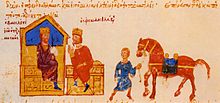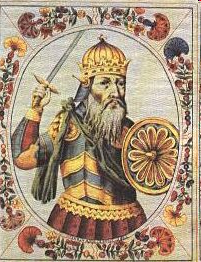Svyatoslav I.
Svyatoslaw I. Igorewitsch ( Old Russian Свѧтославъ Игоревичь , Greek Σφενδοσθλάβος Sphendosthlavos ; * around 942 ; † spring 972 ) was Grand Duke of the Kievan Rus from 945 to 972 .
Life
youth
Svyatoslav was the son of Prince Igor of Kiev and Princess Olga . After the early death of his father in 945, his mother took over the reign until the son came of age. Around 951, Olga was baptized. But she met strong resistance from the upper class.
Beginning of rule
Around 959 he took control of Kiev. He again supported the local religion. The Christian missionaries had to leave the Rus.
Conquests by Khazars and Volga Bulgarians
He began a campaign of conquest against the Vyatiches . With the conquest of the Khazar Khanate (965–969), Svyatoslav extended the influence of the Kievan Rus to the Don and the east coast of the Sea of Azov .

After the subjugation of the Khazars, Svyatoslav turned west against the Danube Bulgarians and in 967 conquered their capital Preslav , which he wanted to make his residence and capital of the Kievan Rus after he had acquired the title of Bulgarian Tsar . Trade policy considerations are likely to have been decisive for this step. However, there are also indications of the warmongering activities of the Byzantine diplomat Kalokyres , who is said to have strived for the imperial crown with Svyatoslav's help. The war against the Bulgarians disturbed the balance of power that had existed until then.
Peace treaty with Byzantium
The following year the Pechenegs invaded the Rus. Shortly afterwards, Emperor Johannes I Tzimiskes , who saw the expansion of Russian rule on the Danube as a danger, sent his troops to Bulgaria. The Byzantines inflicted a series of defeats on the Russians, so that Svyatoslav was forced to sign a peace treaty in July 971. He had to surrender his Bulgarian conquests to Byzantium and renounce any attempt at conquest in the Balkans and the northern Black Sea region .
death
The Khan had the prince captured, killed and made a drinking cup from Svyatoslav's skull.
After Svyatoslav's death there were arguments between his three sons Jaropolk , Oleg and Wladimir , in which Jaropolk first, but then Vladimir prevailed.
Appearance
The Byzantine chronicler Leo Diaconus described Svyatoslav as medium-sized, blue-eyed, shaven with a blonde tuft of hair as a sign of his origin.
Historical evaluation
Because of his many conquests, Svyatoslav is often stylized in literature as a predatory Varangian prince. It should be noted, however, that he was obviously guided by strategic considerations. The war expeditions against the Bulgarians most likely had the aim of controlling the important north-south trade connection between the Baltic Sea and the Black Sea and thereby securing a steady source of income for a long-term rule. In addition, Svyatoslav I had at least loose contacts with the German Emperor Otto I , which led to the arrangement of military actions against the Byzantine Empire, with whom Otto was at war in southern Italy.
literature
- Thomas D. Kendrick: A History of the Vikings. Courier Dover Publications, Mineola NY 2004, ISBN 0-486-43396-X .
- Ralph-Johannes Lilie , Claudia Ludwig, Thomas Pratsch, Beate Zielke, Harald Bichlmeier, Bettina Krönung, Daniel Föller, Alexander Beihammer , Günter Prinzing : Prosopography of the Middle Byzantine Period . 2nd department: (867-1025). Volume 6: Sinko (# 27089) - Zuhayr (# 28522). Created after preliminary work by F. Winkelmann . Published by the Berlin-Brandenburg Academy of Sciences. De Gruyter, Berlin 2013, ISBN 978-3-11-020635-7 , pp. 174-177 no. 27440.
- Aleksandr V. Nazarenko: Rus' i Germanija pri Svjatoslave Igoreviče. In: Istorija SSSR. No. 2, 1990, ISSN 0131-3150 , pp. 60-74.
Web links
Remarks
- ↑ Critical to this, Kendrick: History of the Vikings. 2004, p. 157.
- ↑ Leon Diakonos: Nikephoros Phokas "The pale death of the Saracens" and Johannes Tzimiskes. The period from 959 to 976 in the depiction of Leon Diakonos , translated by Franz Loretto. Graz et al. 1961 ZDB -ID 532553-5 .
| predecessor | Office | successor |
|---|---|---|
| Olga |
Prince of Kievan Rus 962–972 |
Jaropolk I. |
| personal data | |
|---|---|
| SURNAME | Svyatoslav I. |
| ALTERNATIVE NAMES | Svyatoslav I. Igorevich |
| BRIEF DESCRIPTION | Prince of Kiev |
| DATE OF BIRTH | at 942 |
| DATE OF DEATH | 972 |

